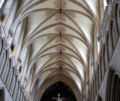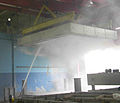- Ceiling
-
For other uses, see Ceiling (disambiguation).
A ceiling (pronounced /ˈsiːlɪŋ/) is an overhead interior surface that covers the upper limit of a room. It is generally not a structural element, but a finished surface concealing the underside of the floor or roof structure above.
-
Painted ceiling, "Icarus", by Rainer Maria Latzke (c. 1986), Chateau Thal, Belgium
-
The ceiling of Wells Cathedral, England
-
Ceiling paintings of Einsiedeln Abbey in Switzerland
Ceilings are classified according to their appearance or construction. A cathedral ceiling is any tall ceiling area similar to those in a church. A dropped ceiling is one in which the finished surface is constructed anywhere from a few inches to several feet below the structure above it. This may be done for aesthetic purposes, such as achieving a desirable ceiling height; or practical purposes such as providing a space for HVAC or piping. An inverse of this would be a raised floor. A concave or barrel shaped ceiling is curved or rounded, usually for visual or acoustical value, while a coffered ceiling is divided into a grid of recessed square or octagonal panels, also called a lacunar ceiling. A cove ceiling uses a curved plaster transition between wall and ceiling; it is named for cove molding, a molding with a concave curve.[1]
Ceilings have frequently been decorated with fresco painting, mosaic tiles and other surface treatments. While hard to execute (at least in place) a decorated ceiling has the advantage that it is largely protected from damage by fingers and dust. In the past, however, this was more than compensated for by the damage from smoke from candles or a fireplace. Many historic buildings have celebrated ceilings. Perhaps the most famous is the Sistine Chapel ceiling by Michelangelo.
Fire-resistance rated ceilings
The most common ceiling that contributes to fire-resistance ratings in commercial and residential construction is the dropped ceiling. In the case of a dropped ceiling, the rating is achieved by the entire system, which is both the structure above, from which the ceilings is suspended, which could be a concrete floor or a timber floor, as well as the suspension mechanism and, finally the lowest membrane or dropped ceiling. Between the structure that the dropped ceiling is suspended from and the dropped membrane, such as a T-bar ceiling or a layer of drywall, there is often some room for mechanical and electrical piping, wiring and ducting to run.
An independent ceiling, however, can be constructed such that it has a stand-alone fire-resistance rating. Such systems must be tested without the benefit of being suspended from a slab above in order to prove that the resulting system is capable of holding itself up. This type of ceiling would be installed to protect items above from fire.
See also
- Beam ceiling
- Coffered ceiling
- Dropped ceiling
- Camp ceiling
- Hammerbeam roof
- Hollow-core slab
- Luminous ceiling
- Moulding (decorative)
- Popcorn ceiling
- Scottish Renaissance painted ceilings
- Stretch ceiling
- Tin ceiling
- Passive fire protection
- Fire-resistance rating
- Fire test
Rooms, spaces, and architectural elements Public areas - Airport lounge
- Auditorium
- Cafeteria
- Classroom
- Changing room / Locker room
- Conference hall
- Doctor's office
- Function hall
- Mailroom
- Library
- Lobby
- Office
- Refectory
- Restroom
- Security
- Waiting room
Passages and spaces Utility and storage - Attic
- Basement
- Box room / Carport
- Cloakroom
- Closet
- Electrical room
- Equipment room
- Furnace room / Boiler room
- Garage
- Janitorial closet
- Laundry room / Utility room
- Mechanical room / floor
- Pantry
- Root cellar
- Semi-basement
- Studio
- Server room
- Wardrobe
- Workshop
- Vault
- Wine cellar
- Wiring closet / Demarcation point
Shared residential rooms Private rooms Great house areas - Ballroom
- Butler's pantry
- Buttery
- Drawing room
- Fainting room
- Great chamber
- Great hall
- Larder
- Long gallery
- Lumber room
- Parlour
- Root cellar
- Salon
- Saucery
- Scullery
- Servants' hall
- Servants' quarters
- Smoking room
- Solar
- Spicery
- Stillroom
- Undercroft
Other areas Architectural elements Related terms - Building
- Furniture
- House
- House plan
- Rooms
 Media related to Ceilings at Wikimedia Commons
Media related to Ceilings at Wikimedia CommonsExternal links
Categories:- Ceilings
-
Wikimedia Foundation. 2010.











